Creating an accessible home is more than just a necessity—it’s a way to enhance independence, comfort, and safety for those with mobility challenges. One of the most important additions to any accessible home is a wheelchair ramp. Whether you’re looking to improve accessibility for yourself, a family member, or a guest, a well-designed ramp can make a huge difference.
In this post, we’ll explore 10 creative and practical wheelchair ramp ideas. From sleek modern designs to budget-friendly options, there’s something here for every home.
1. Straight Aluminum Ramps
Straight ramps are the most common type of wheelchair ramp. They are simple, effective, and relatively easy to install. Aluminum ramps, in particular, offer several advantages:
- Lightweight: Easy to move or adjust if needed.
- Durable: Resistant to rust, corrosion, and weather conditions.
- Non-slip surface: Many aluminum ramps come with textured surfaces for safety.
Aluminum ramps work well for short elevations like a single step entrance or porch. They can be a permanent installation or portable, depending on your needs.
Design tip: Pair a sleek aluminum ramp with modern railing to blend functionality with aesthetic appeal.
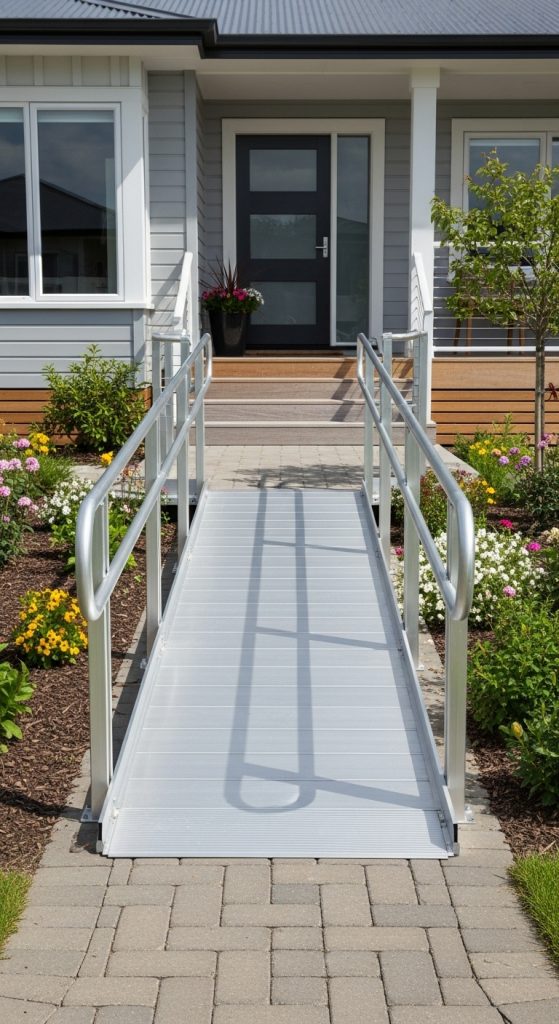
2. Modular Ramps for Flexibility
Modular ramps are made of individual sections that can be assembled in different configurations. This flexibility makes them ideal for homes with unusual entrances or multiple steps.
- Customizable length and slope: Adjust the ramp sections to fit your space perfectly.
- Portable: Sections can be moved or stored when not in use.
- Expandable: Easily add more sections as needed.
Modular ramps are especially useful for temporary solutions or rental properties where permanent installation isn’t an option.
Design tip: Choose ramps with wide surfaces and gentle slopes to ensure safety for all users.

3. Wooden Deck Ramps
A wooden deck ramp adds a warm, natural look to your home. With proper treatment, wood ramps can be durable and visually appealing.
- Customizable style: Stain, paint, or seal the wood to match your home exterior.
- Integrates with existing decking: Perfect for homes with patios or raised porches.
- Strong and supportive: Wood can support heavy wheelchairs when built correctly.
Design tip: Use pressure-treated wood to prevent rotting and add non-slip strips for safety during wet weather.

4. Concrete Ramps for Long-Term Durability
Concrete ramps are a permanent solution for accessibility. They are strong, low-maintenance, and can last decades if installed properly.
- Durable and weather-resistant: Ideal for outdoor entrances.
- Customizable finish: Add textures, patterns, or colors for aesthetic appeal.
- Low maintenance: Requires minimal upkeep compared to wood or metal.
Design tip: Consider adding gentle curves or slopes to the concrete ramp to match the home’s architectural style.

5. Curved Ramps for a Stylish Entrance
Curved ramps offer a unique design element while still providing full accessibility. These ramps are often used in homes with tight spaces or multiple elevation changes.
- Space-efficient: Curves can navigate around obstacles like garden beds or patios.
- Visual appeal: Creates a soft, elegant look for your entryway.
- Custom-built: Typically requires professional installation.
Design tip: Combine a curved ramp with matching railing and landscaping to create a welcoming entrance.
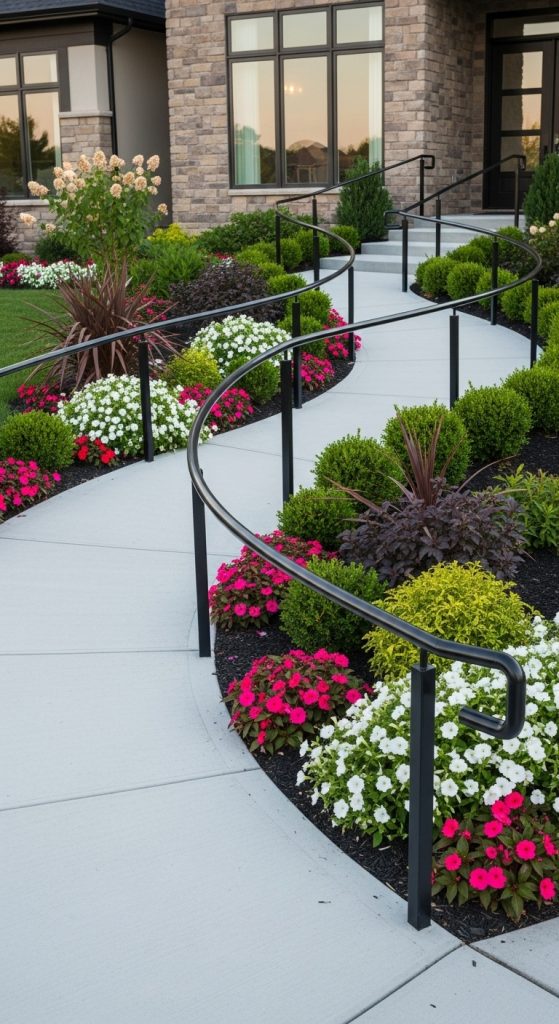
6. Portable Folding Ramps
For those who travel frequently or need temporary accessibility, portable folding ramps are a practical solution.
- Lightweight and compact: Easy to store and transport.
- Quick setup: Can be unfolded and placed within minutes.
- Affordable: Less expensive than permanent solutions.
Design tip: Ideal for vehicles, small stairs, or homes with occasional accessibility needs. Look for ramps with non-slip surfaces and secure locking mechanisms for safety.
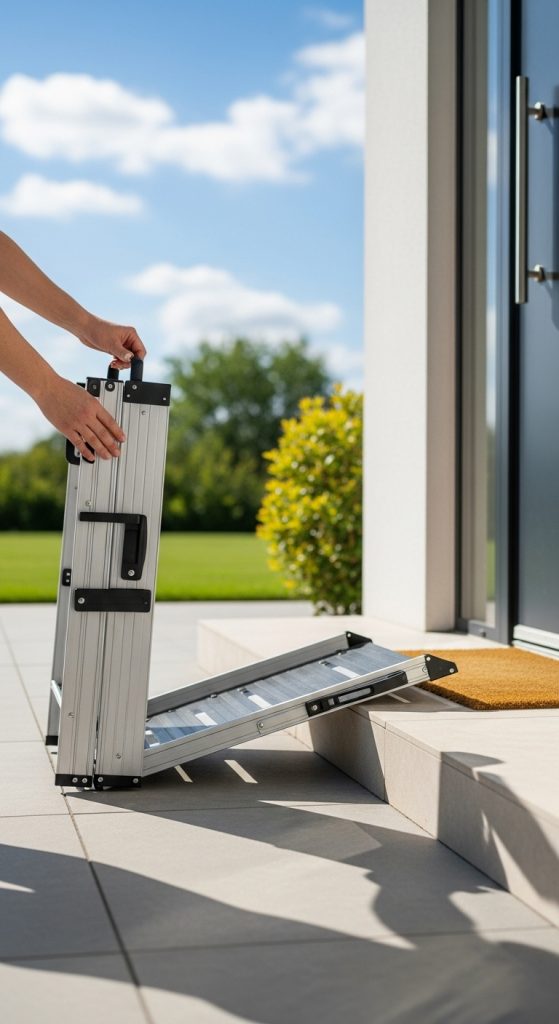
7. Ramp with Integrated Handrails
Safety is a priority for wheelchair ramps. Adding integrated handrails ensures stability for wheelchair users and those walking alongside them.
- Dual support: Handrails provide extra safety for both wheelchair users and caregivers.
- Compliance: Many building codes require handrails for ramps over a certain height.
- Aesthetic options: Choose materials that match your home’s style, such as stainless steel, wood, or powder-coated metal.
Design tip: Handrails should be at a comfortable height and extend beyond the ramp’s start and end points for maximum safety.

8. Ramps with Gentle Slope
The slope of a ramp is a critical factor in safety and usability. Ramps with gentle slopes are easier to navigate, especially for self-propelling wheelchair users.
- Meets ADA recommendations: A slope ratio of 1:12 is ideal, meaning one inch of rise per 12 inches of ramp length.
- Reduces strain: Gentle slopes prevent fatigue for both wheelchair users and caregivers.
- Versatile design: Can be integrated into outdoor landscapes or indoor entryways.
Design tip: If space allows, extend the ramp length to reduce the slope, making it safer and easier to use.
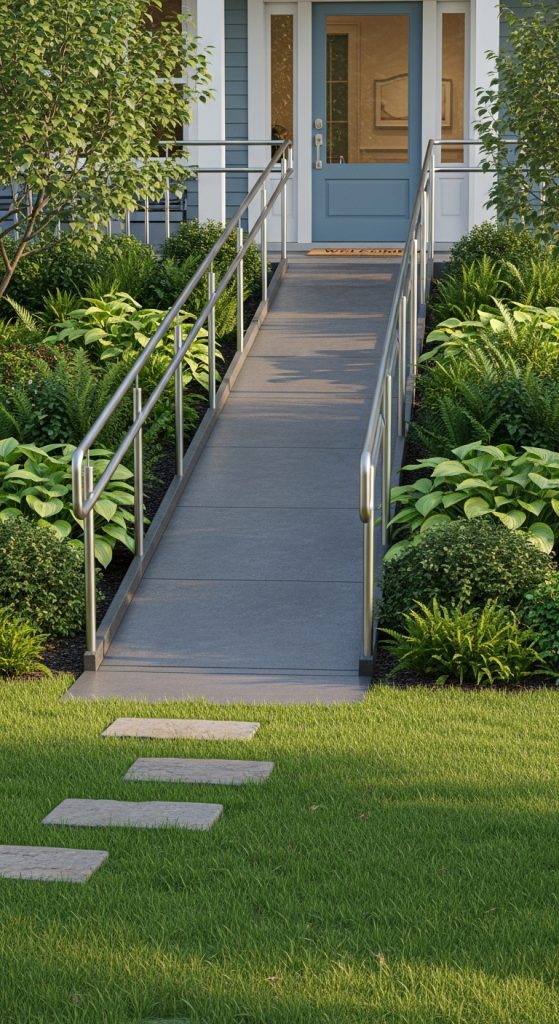
9. Indoor Wheelchair Ramps
Accessibility isn’t just about the exterior of your home. Indoor ramps can help navigate steps between rooms, different floor levels, or raised platforms.
- Smooth transition: Avoids tripping hazards between rooms.
- Customizable materials: Wood, aluminum, or rubberized ramps can blend seamlessly with interior décor.
- Compact design: Ideal for small spaces where large ramps aren’t practical.
Design tip: Choose materials that match your interior flooring to maintain a cohesive look.
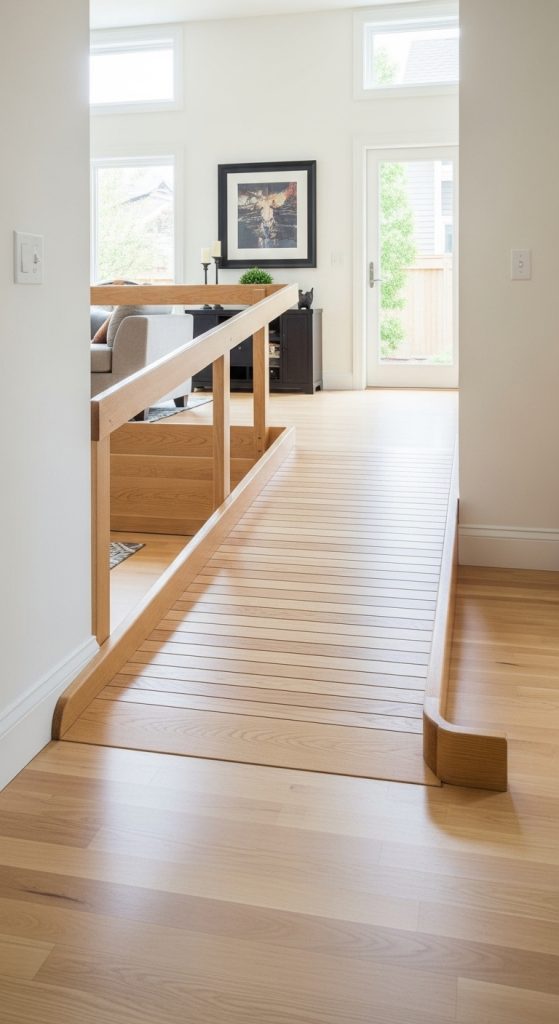
10. Ramp with Landscaping Integration
Why not combine functionality with beauty? Ramps can be designed to integrate with gardens, patios, and outdoor spaces.
- Softens the ramp’s look: Incorporate planters, decorative stones, or edging along the ramp.
- Seamless integration: Ensures the ramp feels like part of the landscape rather than an afterthought.
- Enhances curb appeal: A well-designed ramp can boost your home’s aesthetic value.
Design tip: Add low-height lighting along the ramp for both safety and ambiance during nighttime use.

Additional Tips for Choosing the Right Wheelchair Ramp
- Measure carefully: Ensure you know the height and length requirements to maintain a safe slope.
- Check weight capacity: Choose a ramp that can support the weight of the wheelchair and its user.
- Consider seasonal conditions: Outdoor ramps should be weather-resistant and non-slip.
- Professional installation: For permanent ramps, hiring a professional ensures safety and code compliance.
- Maintenance: Regularly inspect your ramp for wear, loose bolts, or slippery surfaces.
Final Thoughts
Wheelchair ramps are not just functional—they are essential tools for accessibility, independence, and safety. With the variety of styles, materials, and designs available today, you can create a ramp that is both practical and visually appealing.
Whether you choose a simple straight ramp, a modular solution, or a custom curved design with landscaping integration, there’s a ramp idea for every home and budget. The key is to prioritize safety, comfort, and ease of use while also considering the aesthetic impact on your space.
By exploring these 10 wheelchair ramp ideas, you can create an accessible, welcoming environment that enhances mobility and quality of life for everyone who enters your home.